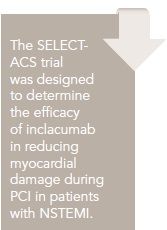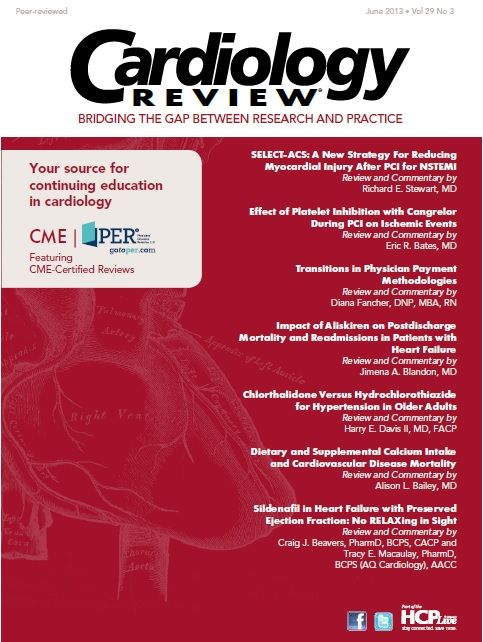Publication
Article
Cardiology Review® Online
SELECT-ACS: A New Strategy for Reducing Myocardial Injury After PCI for NSTEMI

Richard E. Stewart, MD
Review
Non-ST segment elevation myocardial infarction (NSTEMI) is an acute coronary syndrome (ACS) caused by atherosclerotic plaque rupture or erosion resulting in nonocclusive coronary thrombus.1 Other etiologies may include dynamic coronary obstruction from spasm, vasoconstriction, or, less frequently, coronary artery dissection or inflammation. The hallmarks of NSTEMI are elevated biomarkers such as troponin and creatine phosphokinase (CPK) in the absence of ST segment elevation on surface electrocardiogram (ECG). An increase in these biomarkers indicates myocardial damage or injury. Furthermore, elevated troponin I (TNI) levels have been shown to correlate with the short- and long-term risks for adverse cardiac events and death.2

It has been established that the ensuing inflammatory and thrombotic cascade during NSTEMI results in, among other processes, the formation of platelet-leukocyte aggregates.3 Microembolization of these aggregates to the distal coronary vasculature, in the setting of a ruptured plaque, is the most likely cause of troponin elevation. In addition, percutaneous coronary intervention (PCI), with or without stenting, can induce an inflammatory response in patients who have sustained NSTEMI. In similar fashion, TNI elevation is attributed to distal microembolization of platelet-leukocyte aggregates after PCI. Up to 50% of patients undergoing PCI for stable and unstable coronary artery disease have sustained some degree of myocardial damage.4 Multiple strategies — pharmacologic and mechanical — have been employed to prevent or minimize this complication.5
Study Design
The current study by Tardif et al6 evaluates the P-selectin antagonist inclacumab in patients with NSTEMI. P-selectin is an adhesion molecule expressed on activated platelets and endothelial cells. In addition to its role in the inflammatory pathway, P-selectin induces formation of procoagulant microparticles as part of the thrombotic cascade.7 Animal studies have shown that inclacumab, as a human recombinant monoclonal antibody against P-selectin, decreases platelet and leukocyte adhesion and macrophage accumulation after arterial injury.8 The SELECT-ACS trial was designed to determine the efficacy of inclacumab in reducing myocardial damage during PCI in patients with NSTEMI by affecting these pathways.
SELECT-ACS was a prospective, multicenter, double-blind, placebo- controlled trial studying 544 patients diagnosed with NSTEMI. All patients were scheduled for coronary angiography and possible PCI. Median age of the study patients was 61.1 years; 78.9% were male. The percentage of diabetic patients (22.7%) was similar to other PCI trials. Major exclusions included prior coronary artery bypass graft (CABG) surgery, recent thrombolytic therapy, significant blood dyscrasias, and uncontrolled medical conditions such as diabetes mellitus and hypertension.
A total of 322 patients received inclacumab within 24 hours prior to scheduled coronary angiography and PCI. Patients were divided into 3 treatment arms: inclacumab 5 mg/kg (95 patients); inclacumab 20 mg/kg (112 patients); or placebo (115 patients). Study medication was administered as a 1-hour IV infusion. Standard of care concomitant therapy included aspirin, a P2Y12 inhibitor, statins or other cholesterol- lowering medications, and renin-angiotensin inhibitors. TNI levels were drawn at baseline, and at 8, 16, and 24 hours (or at discharge) after PCI in all patients to determine the primary end points of the study. Secondary end points included peak TNI levels and changes in creatine kinase-MB (CK-MB) levels at the same time periods post- PCI. Soluble P-selectin levels were measured in all treatment arms. A safety analysis was performed by the reporting of adverse events, clinical lab studies, and 12-lead ECGs. Statistical analysis of the primary and secondary end points was done using a repeated measure analysis of covariance (ANCOVA).
The trial results showed that treatment with inclacumab at 5 mg/kg did not demonstrate any effect on reducing periprocedural myocardial damage. There was no significant effect on the placebo-adjusted geometric mean TNI level from baseline to 16 hours post-PCI (-3.4%, P = 0.81); 24 hours post-PCI (-1.4%, P = 0.93), or peak TNI level (-1.5%, P = 0.92). However, treatment with the higher dose of inclacumab at 20 mg/kg resulted in a significant decrease in the TNI levels at 24 hours (-24.4%, P = 0.05), and at 16 hours post-PCI (-22.4%, P = 0.07). The peak TNI level was also lower in this treatment arm (-23.8%, P = 0.05). CK-MB levels, as a secondary end point, trended lower in the inclacumab 20-mg/kg treatment arm at 24 hours (-17.4%, P = 0.06) and 16 hours (-16.3%, P = 0.09). There was no statistically significant effect on CK-MB levels in the inclacumab 5-mg/kg treatment arm at 16 and 24 hours (-7.0%, P = 0.50; -4.7%, P = 0.64), respectively. In a subset analysis, the placebo-adjusted mean percentage changes in plasma-soluble P-selectin levels were -9.5% with inclacumab 5 mg/kg (P = 0.25) and -22.0% with inclacumab 20 mg/kg (P <0.01).
The safety analysis showed the percentage of adverse events to be 18.3% in the placebo group, 24% in the lower-dose inclacumab group, and 25.6% in the inclacumab 20-mg/kg treatment arm. Bleeding out to 120 days as an adverse event was seen in 9 patients (5.1%) in the placebo group, 11 patients (6.0%) in the inclacumab 5-mg/ kg treatment group, and 7 patients (4.0%) in the inclacumab 20-mg/ kg group. The number of all-cause deaths up to 120 days after PCI included 0 patients in the placebo group, 4 patients in the low-dose inclacumab group, and 2 patients in the higher-dose inclacumab treatment arm. Overall, most adverse events were of mild or moderate intensity, and were similar in the placebo and active treatment groups. The authors concluded from this study that the P-selectin antagonist inclacumab reduces myocardial damage after PCI in patients with NSTEMI with an acceptable safety profile.
Commentary Early Data on Inclacumab
Since the introduction of coronary balloon angioplasty in the late 1970s, and coronary stenting in the 1990s, adjunctive pharmacologic therapy has been recognized as playing a critical role in patient management. Studies have evaluated agents ranging from oral antiplatelet drugs to intravenous anticoagulants. Most of these agents go through a similar evaluation process in the peer-reviewed literature, including looking at efficacy, optimal dosing strategies, and safety. At the end of this process, a pharmaceutical or biological agent may be deemed clinically inappropriate. An example would be the routine use of warfarin as anticoagulant therapy after routine coronary artery stenting. Conversely, the use of such drugs as clopridogrel and other P2Y12 inhibitors have become the standard of care.
The SELECT-ACS trial is an early study evaluating inclacumab, a recombinant monoclonal antibody against P-selectin. Similar to some clinical trials, such as those evaluating glycoprotein IIb/ IIIa inhibitors, SELECT-ACS evaluated inclacumab as adjunctive upstream therapy in NSTEMI patients undergoing PCI. By studying patients who had sustained NSTEMI, this study focused on the population at high risk for the periprocedural complication of cardiac biomarker elevation (TNI, CK-MB) resulting from myocardial damage. Etiologies include both inflammation and distal microembolization. By reducing focal macrophage accumulation and leukocyte-platelet aggregation in its role as a P-selectin antagonist, inclacumab was believed to have an effect on both etiologies for elevated biomarkers and myocardial damage in the NSTEMI population undergoing PCI.
From a clinical standpoint, 3 important points from SELECTACS stand out; namely ease of use of the study drug, dosing, and safety. A single injection of inclacumab before PCI is attractive for logistical reasons. In the present study design, inclacumab was administered as a 1-hour IV infusion between 1 and 24 hours preceding PCI. The time flexibility of drug administration would facilitate the use of inclacumab before PCI in both scheduled and urgent NSTEMI cases. The higher dose of inclacumab would be preferred for clinical use.
The safety profile of inclacumab seems to be acceptable. As the authors pointed out, despite affecting the interactions between endothelial cells, leukocytes, and platelets, inclacumab was not associated with increased bleeding or infection. The number of major adverse clinical events was small. Despite this, there were 8 deaths and nonfatal myocardial infection (MI) in the 5-mg/kg inclacumab treatment arm, 9 in the 20-mg/kg study arm, and 2 in the placebo group. Some of these deaths were non-cardiac related. The incidence of nonfatal MI out to 120 days in the 20-mg/kg inclacumab study arm is difficult to explain, since the CK-MB elevation was reduced versus placebo.
SELECT-ACS has a number of limitations. First, this was not an intention-to-treat analysis involving all patients randomized in the trial. Second, the amount of myocardium at risk was not quantified in the study by clinical imaging methodologies.
The data from this early study suggest that inclacumab, acting as an antagonist to P-selectin, reduces myocardial damage and injury after PCI in NSTEMI patients. Further investigation will be needed to focus on the benefits and risk profile of inclacumab in patient subsets, including people with diabetes, elderly patients, and patients not undergoing PCI.
References
1. Davies MJ. Pathogenesis of acute coronary syndromes. Circulation. 1996;94:2013-2022.
2. Roe MT, Mahaffey KW, Topol EJ, et al. Creatine kinase-MB elevation after percutaneous coronary intervention predict outcomes in patients with acute coronary syndromes. Eur Heart J. 2004;25:313-321.
3. Boccanelli A, Falsini G, Angiolo, P. et al. Myocardial damage during percutaneous intervention for non-ST-elevation acute coronary syndrome. Eur Heart J. 2005;7(suppl):K15-K18.
4. Nienhuis MB, Ottervanger JP, Zijlstra et al. Prognostic value of troponin after percutaneous coronary intervention: a meta-analysis. Catheter Cardiovas Interv. 2008;71:318-324.
5. Cuculi F, Lim CC, Banning AP. Periprocedural myocardial injury during elective percutaneous coronary intervention: is it important and how can it be prevented. Heart. 2010;96:736-740.
6. Tardif JC, Tanguay JF, L’Allier PL, et al. Effects of the P-selectin antagonist inclacumab on myocardial damage after percutaneous coronary intervention for non-ST elevation myocardial infarction: results of the SELECT-ACS trial. J Am Coll Cardiol. Published 2013. doi:10.1016/j. jacc.2013. 03.003.
7. Blann AD, Nadar SK, Lip GYH. The adhesion molecule P-selectin and cardiovascular disease. Eur Heart J. 2003;24:2166-2179.
8. Phillips, JW, Barringhaus, KG, Sanders JM et al. Single injection of Pselectin or P-selectin glycoprotein ligand-1 monoclonal antibody blocks neointima formation after arterial injury in apolipoprotein E-deficient mice. Circulation. 2003;107:2244-2249.
About the Author
Richard E. Stewart, MD, FACC, FSCAI, is a coronary and endovascular interventional cardiologist at The Heart Center of Bakersfield in Bakersfield, CA. He is Clinical Associate Professor of Medicine in the Cardiology Section of St. Louis University Health Science Center in St. Louis. Dr Stewart received his MD from George Washington University in Washington, DC, and completed his interventional cardiology fellowship at the William Beaumont Hospital in Royal Oak, MI, and a vascular interventional fellowship at the Galichia Research Institute in Wichita, KS.
Tardif JC, Tanguay JF, L’Allier PL, et al. Effects of the P-selectin antagonist inclacumab on myocardial damage after PCI for non-ST elevation myocardial infarction: results of the SELECT-ACS Trial. J Am Coll Cardiol. 2013. doi: 10.1016/j.jacc.2013.03.003, PII:S0735-1097(13)00928-5.






